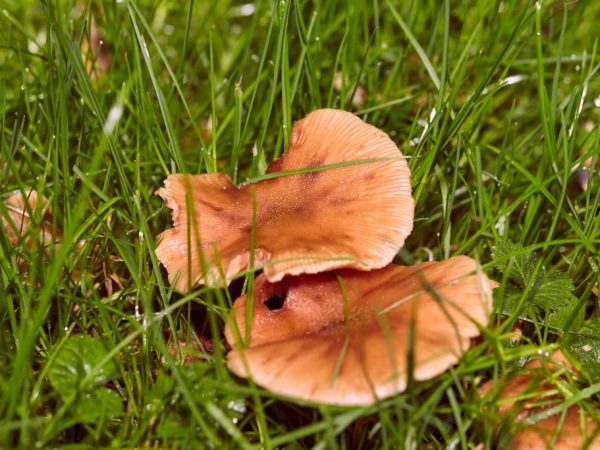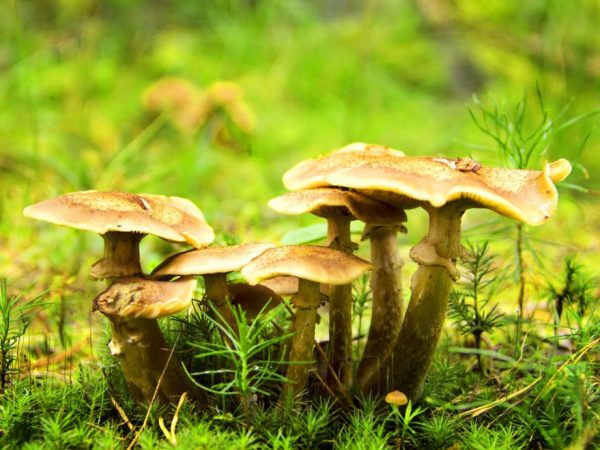Features of overgrown honey agarics
Collecting edible mushrooms in the forest is an interesting and exciting experience, especially in places where there are many of them. It is not always possible to collect forest gifts until the moment they grow old. But overgrown mushrooms, which are often found next to their young relatives, are still popular with mushroom pickers.

Features of overgrown mushrooms
Description of edible overgrown honey agarics
Oversized do not always attract attention with their appearance and taste.
Honey mushroom has a significant advantage - it retains useful properties for a long time. But the appearance of overgrown specimens is significantly different from young fruiting bodies:
- The shape of the cap changes. In autumn honey agarics, the upper part opens with a hemisphere, in summer mushrooms it becomes horizontal and even. The sizes of the caps also increase to 10-17 cm in diameter. The color darkens to brown or brown. The small scales covering the top almost completely disappear, smoothness appears, and moist oiliness disappears.
- The honey agaric has spore plates, which turn from corporal and white to pink or brown in an adult specimen. Spores often leave their container and land on the caps of neighboring mushrooms, a phenomenon similar to mold growing on the surface of the caps below. To test this, simply slide your finger over the moldy hat and you will have spores on the pad of your finger. In older representatives, the spore plates begin to rot and become covered with black spots.
- Overgrown mushrooms rest on thick high legs. Sometimes the lower part begins to grow decrepit, dryish places appear. The girdle, typical of the young Openk, almost completely disappears. False species are devoid of such a mark, therefore edible old mushrooms and inedible ones are easy to confuse and you need to be extremely careful.
- Young specimens are known for a strong, pleasant smell that lasts even when cooking. Overgrown fruiting bodies, if they do not rot, have the same odor, but it is weaker. False mushrooms are endowed with an earthy unpleasant trail, which distinguishes them from edible relatives.
Irina Selyutina (Biologist):
Yes, some of the fans of "quiet hunting" do not pass by overgrown mushrooms. They consider them quite worthy prey. However, before they send such a mushroom to the basket, they check its quality and if it suits them - you are welcome.
On the basis of what do overgrown mushrooms choose? Let's take a look at the selection criteria:
- Ecologically safe (clean) area.
- Even the smallest damage or black spots should not be on the surface of the fruiting body.
- Signs of worminess may not be present.
If the caps below the old mushrooms in the colony are covered with something resembling mold, you can check whether this is so by not only removing it with your finger, but also sniffing the air near this "suspicious" cap. If you catch a pleasant mushroom aroma, everything is in order, but if you smell mold, it is better to leave the mushroom alone.In addition, pay attention to the hymenophore of the old mushroom - if the plates are covered with mold and even begin to turn black - we also pass by.
Overgrowths can grow in forests on clearings, stumps, old fallen large branches and in other places. They can be confused with inedible mushrooms. Young fruiting bodies coexist with old ones on the same territory. By the way. The overgrown representatives of the autumn mushroom species lose the ability to glow mycelium at the time of full maturation.
Taste qualities
Honey mushrooms are prized for their exceptional scent and the ability to collect large quantities in a short time.
Young mushrooms have strong and firm white flesh. An edible adult honey fungus loses its ability to retain juices in the fruiting body. Therefore, its leg often dries up, the flesh becomes whitish-gray or yellowish, friable.

The taste of young and adults is the same
Both young and adult mushrooms have little difference in taste. In some European countries, gourmets even prefer overgrown ones - the firmness and fiberiness of the pulp is more appealing to their tastes. When cooking, do not use rotten, wormy and false specimens, because they will give the dish an unpleasant smell and a bitter aftertaste.
Cooking honey mushrooms
The collected overgrown mushrooms are cleaned before starting any processing. The legs are removed, the caps are checked for the presence of worms, and if there are any, the fruiting bodies are discarded. Spore-bearing plates are removed with a knife or a hard part of a washcloth.
The remaining high-quality fruit bodies are soaked in cold water for 40-50 minutes. For better cleaning of mushroom caps from parasites, add 2-3 tbsp. l. common salt. It is recommended to change the water three times to achieve maximum results.
If the mushrooms go for drying, then their contact with water is minimized. Removal of spore plates is carried out with a damp washcloth, which simultaneously removes dirt from the cap. Fruiting bodies are left in a sunny, ventilated place until fully cooked. Then they are ground into powder or cut into pieces, added to soups and side dishes, salads, pates and other dishes.
By the way. If the legs of overgrown honey agaric have a "decent" appearance, they can be used after separation from the caps to prepare caviar or pâté.
Heat treatment is carried out before cooking adult mushrooms. It is divided into 2 sets of 15-20 minutes duration. Each time, the water in which honey mushrooms are boiled is changed to clean water. After that, the overgrown mushrooms are added to different dishes:
- after half an hour of cooking, the hats are pickled with the addition of spices, served on the table as a ready-made dish, appetizer, side dish;
- fried in sour cream, with vegetables, potatoes, onions, served as a main course;
- added to soups and sauces, used as filling for pies.
Conclusion
Overgrown mushrooms are used as often as young ones. The appearance of the mushrooms, the smell, the state of the pulp helps to determine the degree of friability of the fruiting body, therefore the question of collection is decided even in the forest. Old mushrooms can be dangerous if harvested from industrial areas or from busy roads.


